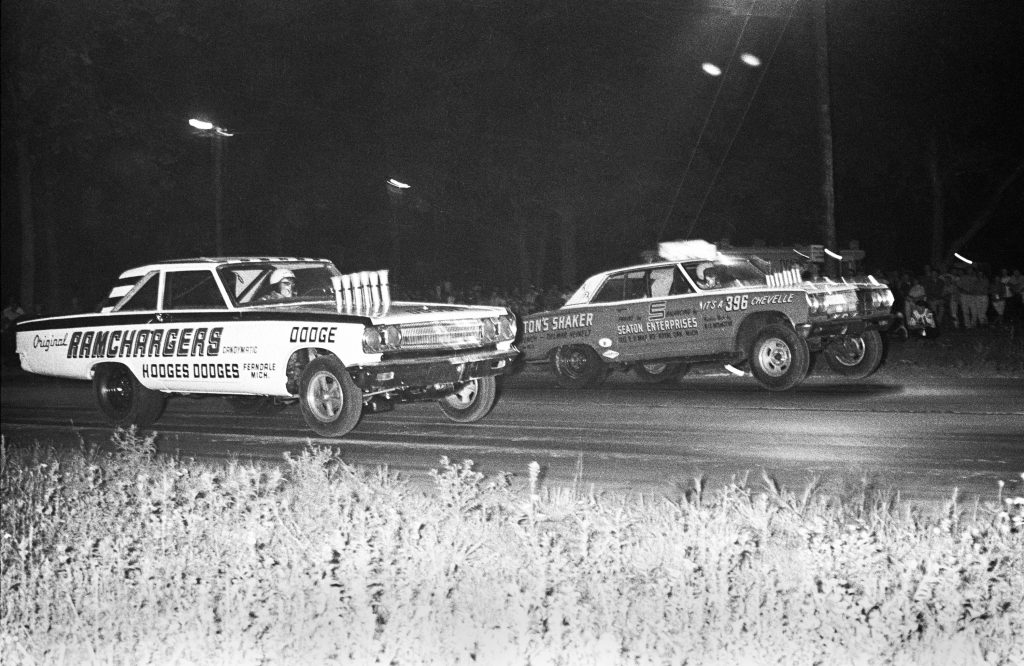The Ramchargers Go Match Racing–On Nitro!
1965 was drag racing’s finest year.
By Dave Rockwell
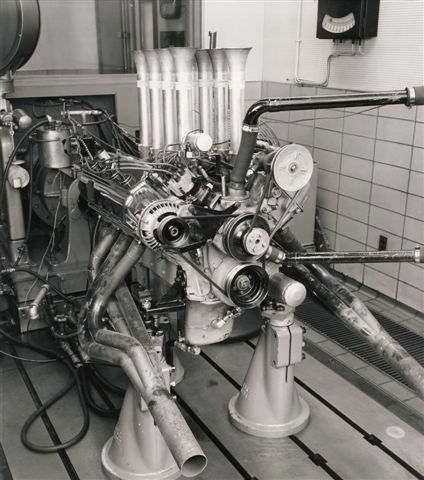
Â
In effect, 1965 saw the full unleashing of a drag racing arms race beginning at the Pomona Winternationals. With Ford’s decision to install its superior SOHC 427 motors, in lightened compact Mustangs and Comets the Ramchargers and Chrysler’s race group were inspired to take drastic steps. By March, Dick Landy had taken his AWB Dodge to a resounding victory at Bakersfield as Ramcharger members were developing the Chrysler/Hilborn fuel injection system. This was fortuitous with the proliferation of nitromethane, on the match race scene, requiring the use of fuel injection. The alchemy offered by greatly improved traction from the Altered Wheelbase design in combination with nitromethane flowed by the Chrysler/Hilborn fuel injection system, delivered unimagined performance gains. And even more importantly for the Ramchargers, the ability for Chrysler cars to establish dominance in the wildly popular world of match racing.
On June 24, the team traveled to their favorite track, Cecil County, for a match race with Arnie Beswick’s blown GTO. Cecil County advertised itself as the “traction capital of the East,” and the Ramchargers cars were in love with traction. Bud Faubel was in attendance, and, indicative of his trusted status with the Ramchargers, Dick Maxwell intimated to him that the Ramchargers had brought their “A/Gas Supercharged (stroker) motor” for Mr. Beswick. Bud chuckled and nodded his approval. But it also had been decided their supercharged opponent deserved a counterpunch, so what better time to try 30% nitro methane in the tank?
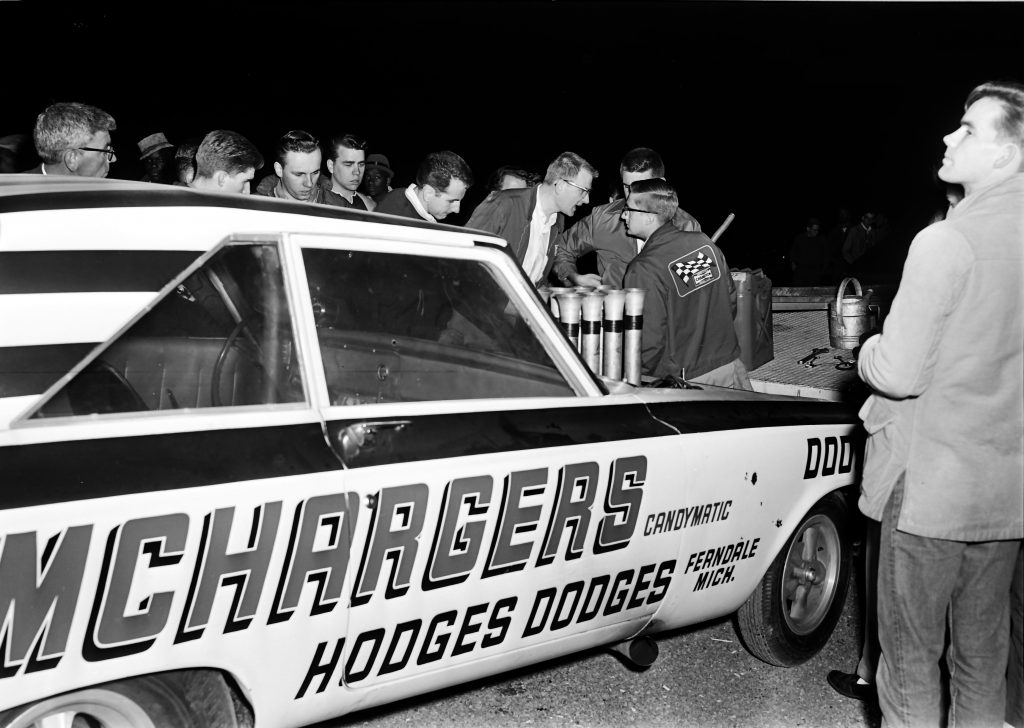
Â
For the first round race the team swung into their track prep protocol, which also had become a favorite with crowds. “Dirty” (nickname by virtue of his usually clean clothes) Dave Rockwell describes it, “after studying the track for the best groove to run the car in we would line it up several car lengths behind the starting line. Working from there we swept two tracks forward about 100 feet past the starting line. We always carried a 5-gallon keg of powdered rosin for filling canisters with holes in the top. Walking backwards from the car past the starting line we shook the canisters spreading the rosin in the two grooves, then broomed the rosin in for a smooth layer all the way out. The whole ritual probably took five or 10 minutes, depending on the track. Then we always carried a squirt oil can converted for priming the fuel injection stacks with fuel because the injectors had no pump shot. So after the National Anthem it was just a matter of priming each injector tube and Jim hitting the switch and the car was ready to go. Then we had gallon bleach bottles we filled with acetone from which we then poured a decent puddle in front of each slick, followed by the high sign to Jim for the burnout. He then would spin through the acetone, or “glue” as we called it and then burn through the powdered rosin. After the first burn through the rosin could be blowing around pretty well and his tracks would be relatively light. But, after a couple more shots, the tracks would be jet black, the tires would yelp when he nailed it and you could lose a shoe if you stepped where the car had just launched. At Cecil that night it was totally hooking up.”
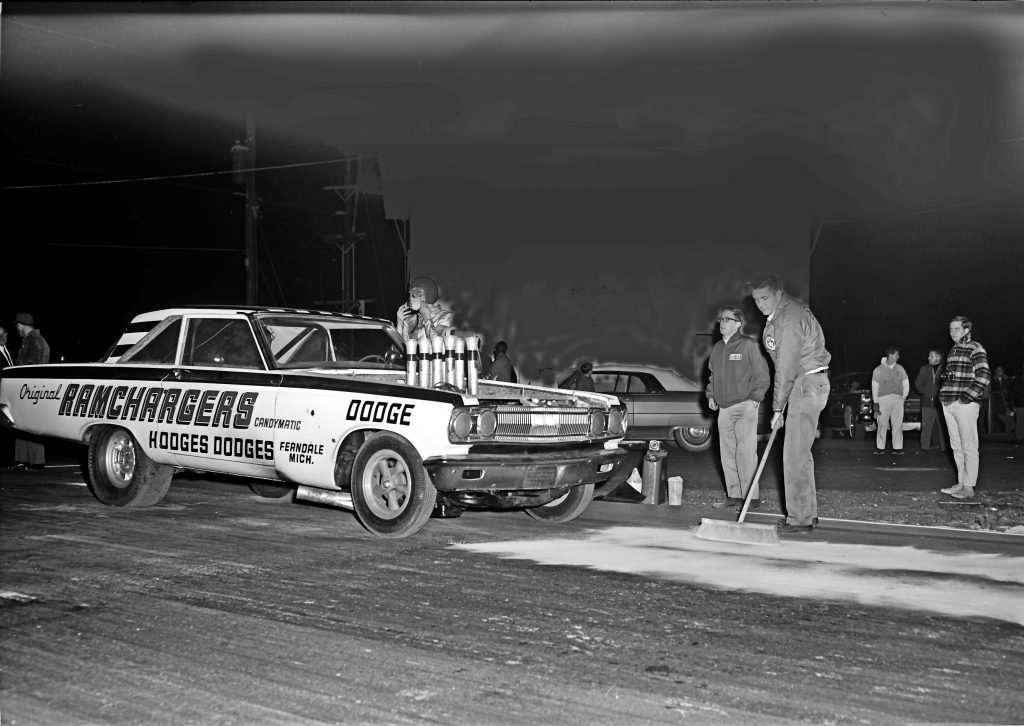
As Mike Buckel adjusts his fire suit and Tom Coddington looks on, Dick Maxwell brooms in powdered rosin initiating the Ramchargers burnout ritual. (Photo: Ramchargers Archive)
Â
Beswick won the customary coin toss for lane selection and put the Ramchargers in the left lane with Arnie taking the tower side. When the Christmas tree came down the cars launched together with Arnie carding an all-time best 9.81 seconds. But, by that time, Mike Buckel was long gone. With Jack Chrisman in his celebrated supercharged, fuel-burning Comet having set the Cecil record the week before at 9.69 seconds, no one in the sport was prepared for a 9.19 at 145.86 mph. But there it was, five full tenths quicker than the fastest blown car in the sport! For further comparison, Bud Fauble’s best the following day at Cecil was a 9.92 at 138 mph and it would be another week before Dyno Don carded his first fuel injection-aided nine-second run at 9.98. The 9.19 run was backed up by two more 9.20 runs. The excitement of the extraordinary leap in performance drew other Factory Experimental racers to the starting line for the last two passes with much fist pounding, cheering and camaraderie. Al Procopio, Cecil’s proprietor topped the evening off by proudly taking reporters to the timing tower to photograph the clocks.
With Arnie Beswick fading fast as GM’s great hope, Detroit’s Pete Seaton was finishing the first Chevrolet in some time capable of defending itself in the factory wars. Pete was the well-educated son of Louis Seaton, Vice President of General Motors in charge of Labor Relations. He also was a fixture on the Detroit street race scene and had been in the finals at the 1960 Nationals in a sister car to the Royal Pontiac. Born with a rare blood disease he was small in stature, pale in color and increasingly confined to his ever present, air-conditioned four-door Pontiac Brougham, from which he ran the racecar. A buddy to several Ramchargers from Woodward Avenue days, his newest creation was anticipated to be a cut above other current GM match racers, and it did not disappoint. In addition to some clever engineering to improve weight distribution, Pete’s car also sported a non-existent, “engineering only” prototype 427 inch race block provided by Chevrolet’s, “nonexistent” Race Group. The “nonexistent” block was easily disguised by emblazoning the front fender with “It’s a 396 Chevelle!” given the 396 was barely recognizable due to its newness. Sporting fuel injection, Pete laughed in Ford’s face by never letting gasoline any closer to his racer than the flatbed. He joked his Chevelle’s Moon fuel tank would never see less than 65% Nitro. And he meant it.
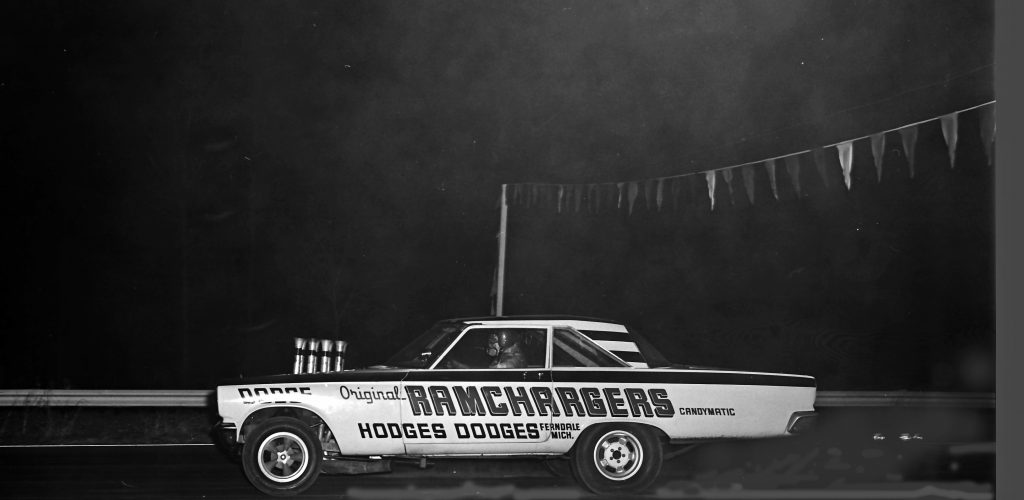
As ever, Gil Kohn knew a good match when he saw one, so on July 7th the Ramchargers found themselves opposite Pete’s two-week old, Seaton’s Shaker at Detroit Dragway. It was a warm Saturday evening in the middle of a dry spell, which at Detroit Dragway meant… dust. Spectators sat on a hill running the length of the western side of the drag strip, which had been excavated in the process of creating safety trenches on both sides of the track. It essentially was a mound of dirt behind which was a loose dirt parking lot. On nights such as this, the hot August Westerly could carry the ancient lake bottom silt from the parking lot over the spectator’s earthen mound and shower it on the strip surface. Under the track lighting it looked like curtains ofgolden fog.
Dick Maxwell previously had explained that trying out new parts could bite you, and this evening’s first round proved the point. As Buckel staged, tucked invisibly in the rear end was an experimental aluminum assembly. After three strong burnouts and a green light, the low- pressure wrinkle wall M&Hs turned less than a revolution before the gear assembly failed, sending Delmar Heinelt in Seaton’s Shaker to a first round victory. Back in the pits the failed “high-strength alloy” rear end was replaced with the tried and true, Chrysler 8-3/4 inch, 4.56 unit. Also, in the game plan for the evening was to run gasoline as Seaton’s heavy load of nitro had not been anticipated. In fact, he was the first to really try it, and although he had made a surprisingly quick 9.80 pass in the first round, the consensus was the gasoline combination should still be able to handle him.
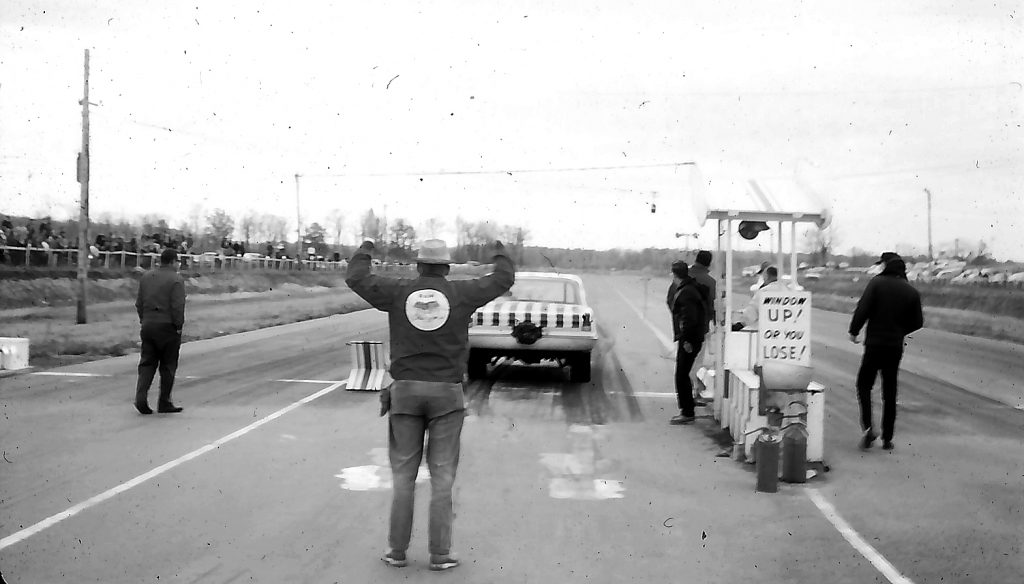
Â
But Delmar was on top of his game, sawing the tree down on Buckel, and Seaton’s loaded for bear Chevy would not be run down. Unexpectedly and suddenly, down two races to none, the decision was made to install the 30% nitro combination. For Buckel, this meant donning a fire suit and getting behind the wheel of the “turkey” on nitro for the first time. Long before driving schools it was a tough situation to learn in. He recalls, “I just remember that night because everything was different, taking the fire suit out of the box, wearing a respirator and mask, you couldn’t see very well. It was later in the evening and there was some dew settling and I was reaching in through the holes in the face mask to try to get the fog off my glasses because I was sweating and puffing trying to breathe through the respirators. It was something you get used to, but really disorienting and uncomfortable at first.”
Dave Rockwell continues, “that was the first time I ever saw us losing with that car, and then with the nitro and all, suddenly everything seemed a lot more serious. Seaton’s car was reacting like a bomb, really violent and quick and you could also tell the track was getting slicker, it had sort of a sheen from the dirt. It was the first time the full reality and danger of what we were doing really seemed clear to me. It usually felt like we were in control, but at moments like this you realized how close you were skating to the edges of technology. Putting your best out there didn’t give you any guarantees and there was no backing down, it was Mono Mono time.”
Buckel continues, “we had the M&H’s down to like 4 PSI trying to get some bite and the car really launched hard but not very straight. In second gear it really began to go sideways and with those tires you had no lateral control, so I shut it down and it just slid and slid and eventually it hit the dirt, hooked the tires and flipped and rolled over on its roof, down into the safety ditch. But, with the fuel injection, the motor continued to run so I pulled the fuel shutoff valve in the center of the dash and found myself hanging by the seatbelt, and I’m thinking, I’ve got to get out of here… so I was able to get the belts undone and fell on my head and rolled out the plexiglass window into the green water with the frogs. Later on we found if you could turn the power back on you could drive it out of those deals but at that time, when you were sideways looking at the side of the dragstrip, turning the power back on wasn’t at the top of your list of things to do.”

How would Ramchargers react? Dick Maxwell intimates, “after we got back to Ferndale and put the transporter and car in the garage, I invited the guys back to my house for a beer where we just sort of sat around and talked for a while. I don’t remember what we talked about, it was pretty low-key, but it probably was our version of a group hug.”
Behind locked doors, the next weeks’ evenings were a bonzai charge to rebuild the racer for the following weekend. The roof had been crushed down and the quarter panels bent, so after removing the drive train, the body was rushed to the Alexander Brothers on Tuesday morning for emergency reconstruction. Meanwhile, Hoover recalls, “Danny and I spent that week rebuilding the motor fishing out tadpoles and swamp grass. It had ingested all manner of trash running upside down in that ditch.” By Friday night it was race ready, albeit in gray primer on much of the roof and quarter panels as the team headed out for Cecil County.
It was Jim Thornton’s turn to drive in the best of five races with Harold Ramsey’s supercharged GTO, and the team was determined to bounce back. The decision was made to not only stick with nitro, but to boost the load for the first time to 50%, it was Cecil County after all. Electing to go without a checkout pass, the team went straight into their burnout ritual for the first round. Drag News describes what happened next. “Although the car was unpainted and not very impressive looking from its recent accident, the Hilborn injector stacks flew by the spectators and stopped the Chrondek timers with a… 8.910 time at 148.66mph! This brought photographers and strip personnel all to the tower to see for themselves. And sure enough there it was, another impossible feat performed by the factory engineers… becoming the first full-bodied car to ever go into the eight second bracket!”
For comparison, mid-to high nine-second runs were sufficient to win the first Super Stock Nationals, sometimes referred to as the Woodstock of drag racing, being held the same weekend at York Dragway. The historical perspective is even more stunning. With the best Factory Experimental time at the 1965 Winternationals being a 10.91, the 8.91 run reflected a full 2- second improvement within the same season, while arguably, being accomplished by the same team. In subsequent years, appreciable improvement could be 100th of that!
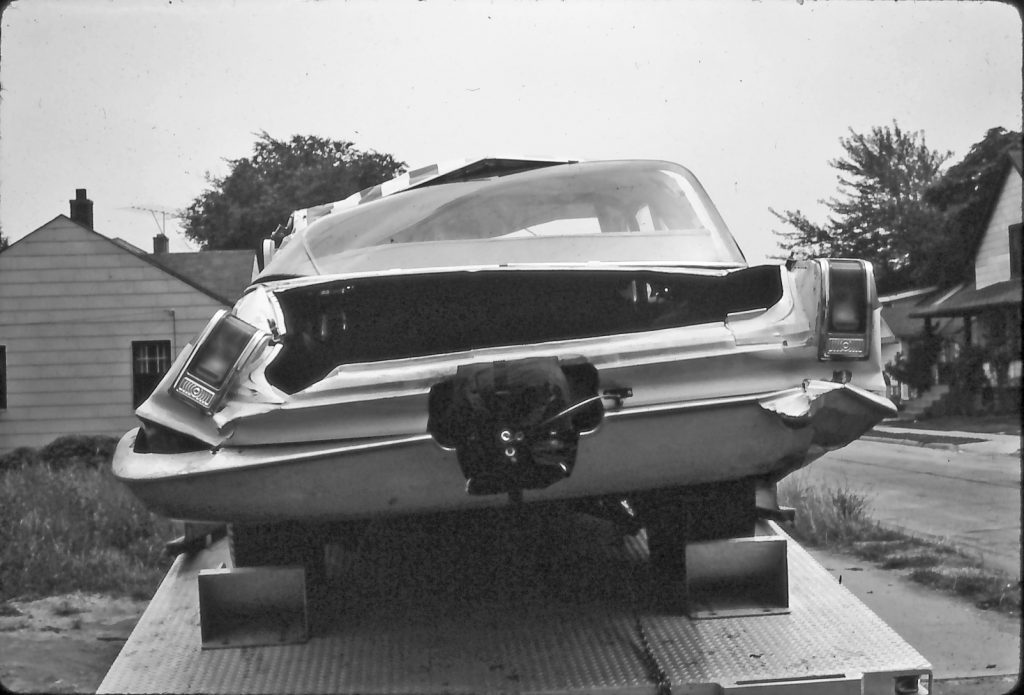
garage after their July 1965 match race with Pete Seaton. (Photo: Ramchargers Archive)
By the third week in August, the Factory Experimental was on another unbeaten streak when it was time for a rematch with Seaton’s Shaker at Detroit. With over a months’ racing under their belts, Pete’s car was running better than ever, and smelling blood would have everything in the tank from the nitro can but the label. Anticipating this, the team came with a steel rear end this time and 30% in the tank. The first two rounds were close wins for the Ramchargers, but with Pete’s car having spectacular and explosive throttle response, twisting the left front wheel four feet in the air every time Delmar nailed it.
Delmar was doing a marvelous job of controlling a car that was scary to watch, much less drive. In the third round he was able to get out on Buckel and held on for the win. The fourth round produced a dĂ©jĂ vu in reverse of the two teams’ first meeting. It was later in the evening, with the cars doing their final burnouts as they approached the starting line, Delmar nailed it one last time and with a violent twist the front fiberglass bumper broke, dangling down on one side. Tom “Snake” Jones, Seaton’s well traveled head wrench ripped it off, much to the satisfaction of the cheering crowd. The cars staged and left together with Delmar driving it hard on two, then gradually three and four wheels. By that point he was deep into second gear and fully committed to the race when the car hooked the trackside, launched down into the retaining ditch and rolled several times. With a sigh of relief from everyone, a shaken but otherwise unhurt Delmar grinned to the guys, “we’ll have to have some more fun soon”. He was all drag racer.
